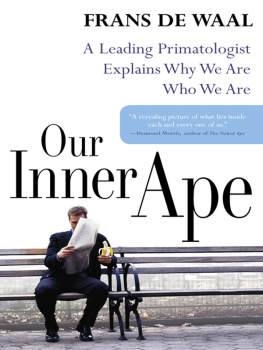I wanna be like youoooo
When the chimpanzee fell from grace as the peacefulvegetarian, who would have thought that lurking in the shadows was anotherhairy cousin, and a much better one at that. This hippie starlet, quietlywaiting in the wings, was so much like the chimpanzee that for some time shewas known (to those few who knew her at all) as the pygmy chimpanzee. Afterdecades of obscurity, this budding star gradually (over even more decades) madeher presence known. Now, finally, her breakthrough has come, and her cue to takecentre stage has arrived. So, if you dont want to be a chimpanzee thatnasty, brutish ape you can now choose the new and improved version: thepeaceful and free-lovin bonobo. Cue Lights, Camera, and...Action!
From virtually all social media talk, it seems that whateveryone absolutely knows about the bonobo is that it is all about the sex.Whether its an image of one great big cuddly love-in or, more bluntly,everyone simply banging everyone else, it is the sex that has led the bonobodown the path to a peaceful, easy-going bliss. Watching bonobos at feeding timeat the zoo, or even the videos of them at artificial feeding sites in the wild,it is hard not to be bemused by all their sexual antics. This is how they avoidconflict, we are told; surely this is how we too can do the same. Thosechimpanzee cousins of ours dont do this kind of thing and we all know howhorrible they can be.
So today there is the most enticing, lascivious lightshining through the dark cloud that hangs over human nature. This is the motherof all indecent exposures: our inner bonobo. If only we can set her free wewill wipe out war and conflict and violence. Can any of us refuse the call torelease this joyous sexual panacea?
If only it were that simple...
The Bonobo.
Sexy. Gentle. Friendly.
The make love not war ape. At last an ape to emulate. Lotsof sex: females with males; females with females; males with males; adults withchildren and infants...
Hold on a minute.
A mother-son relationship so close that shes a guysfavourite wingman: shell chase other guys out of the way so that her son canliterally get the girl. No bonobo embarrassment about being tied to mothersapron strings here...
Yikes.
No groups of males causing any trouble. No war. No bands ofbrothers. No male teamwork. No male team sports. No football...
Now, that really is going too far!
It is not that some less than appealing bonobo features suchas these are unknown, only that they have been largely avoided or ignored. Whenit comes to the extremely delicate issue of sex involving children and infants,this is not on the public agenda of most wannabe bonobos. Those who thinkdifferently will, as well see, not get the kind of support they might beexpecting from the bonobo anyway. But sex involving infants and juveniles(youngsters between infancy and puberty) is an important aspect of bonobo life,and not something to which we can easily turn a blind eye.
As for mothers and apron strings, and guys and their teamsports, these are probably the biggest blocks to the release of the innerbonobo for the males amongst us. Is the promise of rampant sex enough tocompensate? Or is the male wannabe bonobo expecting to have his cake and eat ittoo? As for the gals, it would all seem something of a feminist paradise. Wellsee if it is.
We are, as zoologist Desmond Morris pointed out to us backin the 1960s, naked apes (Morris 1967). But are we, as some now think, naked bonobos?Before we jump in, genitals first, perhaps we need to take a step back andconsider the wider picture of bonobo behaviour. Might there be some aspects ofbeing a bonobo that are not going to go down too well; aspects that require alittle more scrutiny before we take the bait of peace and love promises?
For the naked ape and especially for the wannabe nakedbonobo it is time to take that step back and have a good look at this thisnew-found, rising-star, cousin of ours. It is time for the bonobo to layherself bare.
One: the forgotten ape
In 1997, in the preface to his book Bonobo: The ForgottenApe, Frans de Waal made the point that books and articles on the other apescould easily fill a small library, but for a complete collection of literatureon bonobos, a single cardboard box would do. At that time few had even heard ofthis ape but now, nearly two decades later, the bonobo takes the spotlight inmany a discussion about human nature. It seems that we are finally getting toknow our peaceful, hairy cousin; a peace achieved primarily (so we are told)through constant, casual sex.
Bonobo: The Forgotten Ape is full of wonderfullyendearing bonobo photographs (though the unnaturally reproduced redness of thelips and skin is a little unfortunate). The man who captured these images,wildlife photographer Frans Lanting, describes in the book how finding and thenkeeping up with bonobos in their natural forest habitat was no easy task.Whats more, if he did find them, photographs of black animals in a dark forestwerent going to show us much anyway. As a result, most of the photographs inthe book are either of bonobos at the artificial feeding sites, or they arephotos of captive apes, used to show close-ups and subtle expressions.
While it is inevitable that most of the images we have ofbonobos are from zoos or from the cleared areas of feeding sites (where theyare often seen clutching their sticks of sugarcane), it can leave us with adistorted image of this ape. We have to remember that the world they normallylive in is a world of trees and, while they will feed and travel on the groundand through the undergrowth, they spend most of their time traveling, feeding,and sleeping high in the forest canopy. Bonobos are particularly agile in thetrees; their long-legged, slender body once thought to show a closerconnection to our own is now recognised as a body-type well-suited to theirlargely arboreal life (White 1992).
The very same problems Frans Lanting experienced when tryingto find and then follow bonobos in their natural forest habitat, plus the factthat this region of Africa has seen some of the most harrowing and long-runninghuman conflicts, is why, even today, we know relatively little about theseapes. Most of what we do know still comes, like our images, from tiny captivepopulations or from bonobo behaviour at the artificial feeding sites.
Frans de Waal is probably the only writer on bonobos who isfamiliar to the vast majority of bonobo enthusiasts. His major interest hasbeen reconciliation behaviours across primates rather than simply this onespecies but the results from his study of a small group of bonobos at San DiegoZoo have massively impacted how most of us see this ape. Zoo studies have beenuseful in highlighting behaviours particular to bonobos but their use, ofcourse, is limited. (Imagine if some alien visitors to our planet killed somemothers for food, took and traded their infants, and that these infants, andtheir descendants over time, end up in various zoos on the alien planet. Whatwould alien scientists learn about us? Life for a bonobo may be far lesscomplex than our own but it is far more complex than is ever going to be foundin a zoo enclosure.)
Though our literature on bonobos has increased since 1997,it would still fit into a (somewhat larger) cardboard box. For those of usfeeling the rumblings of an inner bonobo on the verge of breaking loose, itwould be foolish not to at least take a good look inside that box rather thanleave its contents to the workings of the sometimes over-excited humanimagination.
Our first discoveries about bonobo behaviour came fromobservations of very small zoo populations. Frans de Waals early 1980s studyof the bonobos in San Diego Zoo is the most detailed of these, and it is deWaal who has been responsible for most of our general understanding of thisspecies. Not surprisingly, it has been the sexual behaviours of the bonobo thathave grabbed our attention, and the value of de Waals broader concern withreconciliation and peacekeeping behaviours across species usually loses out tothe titillation of bonobo sex.










